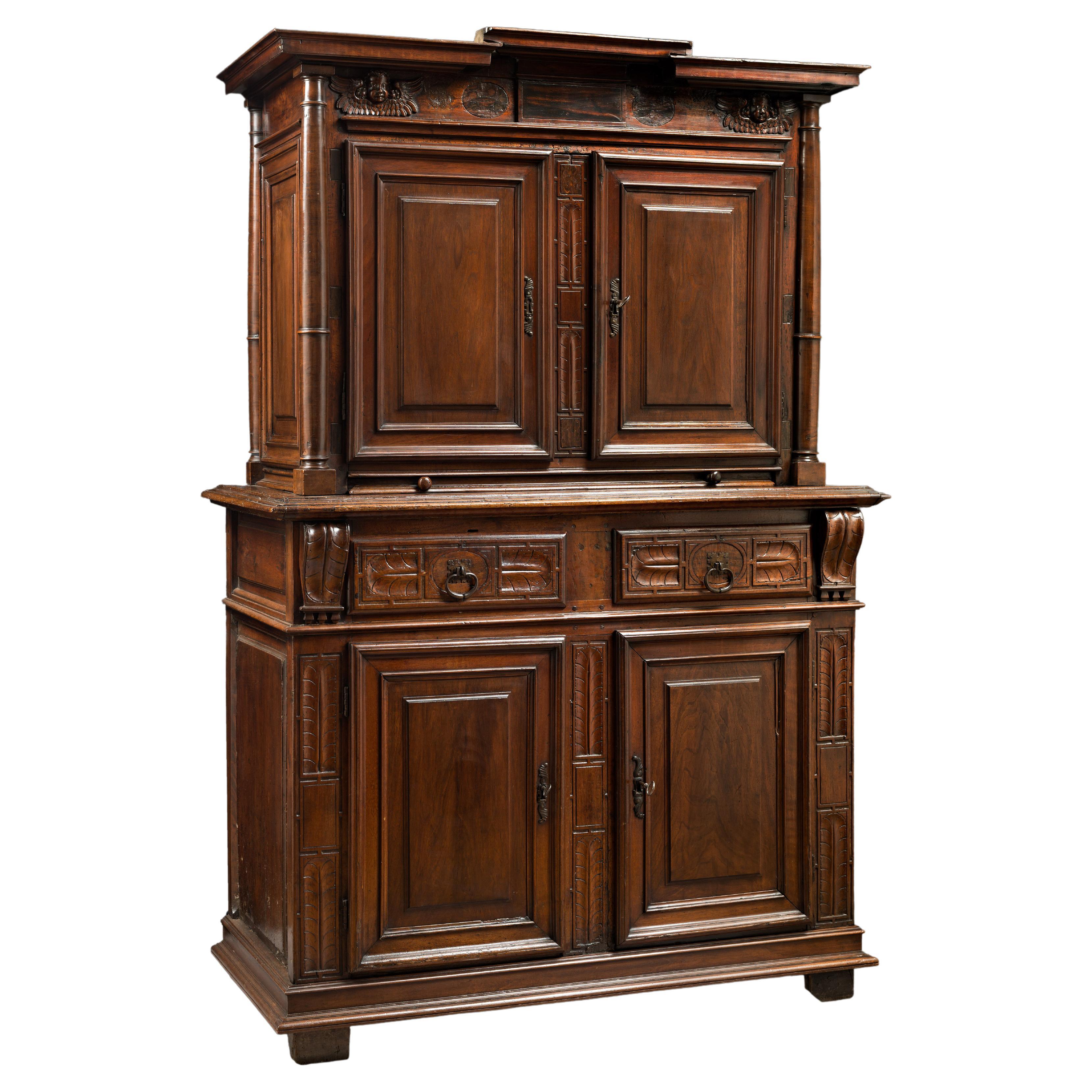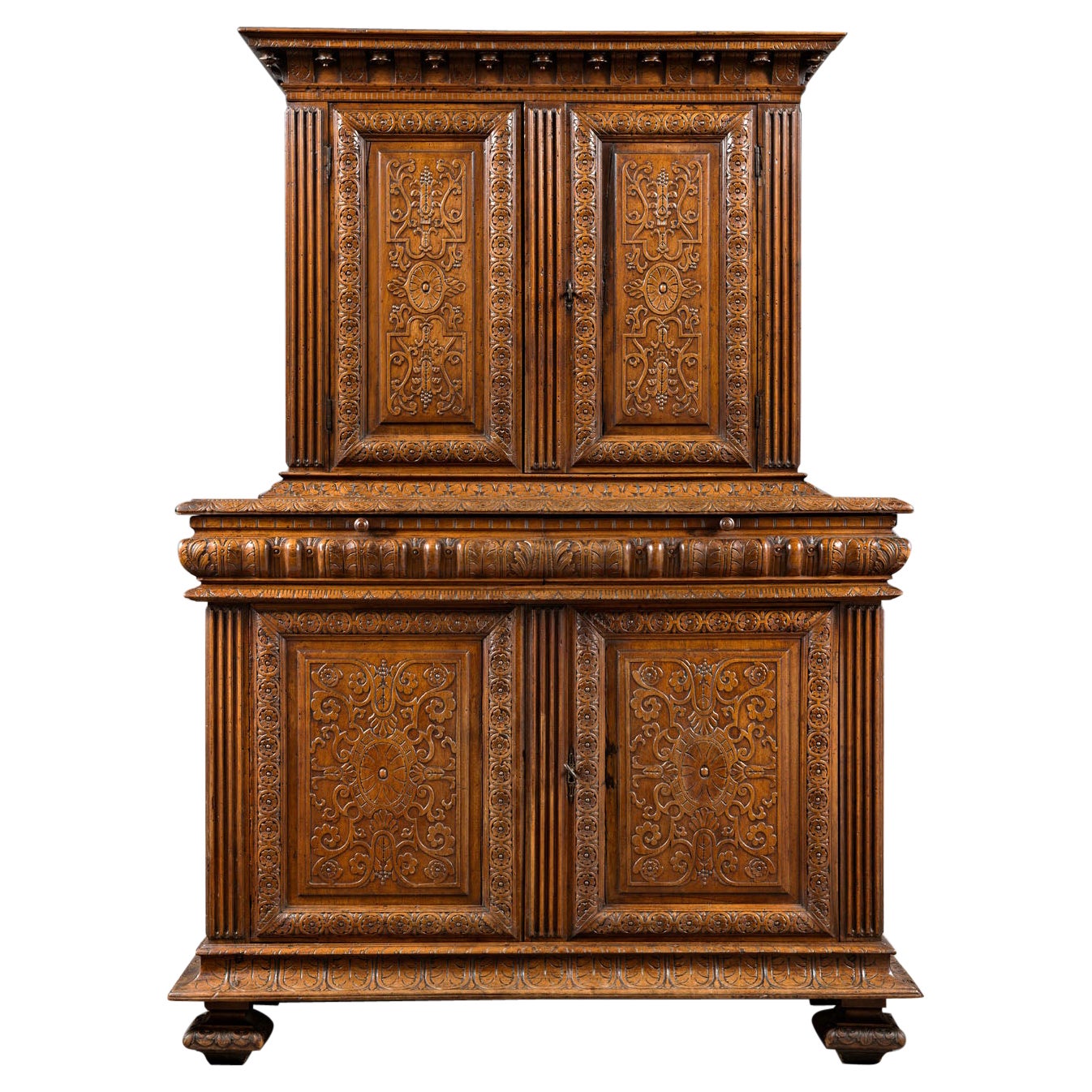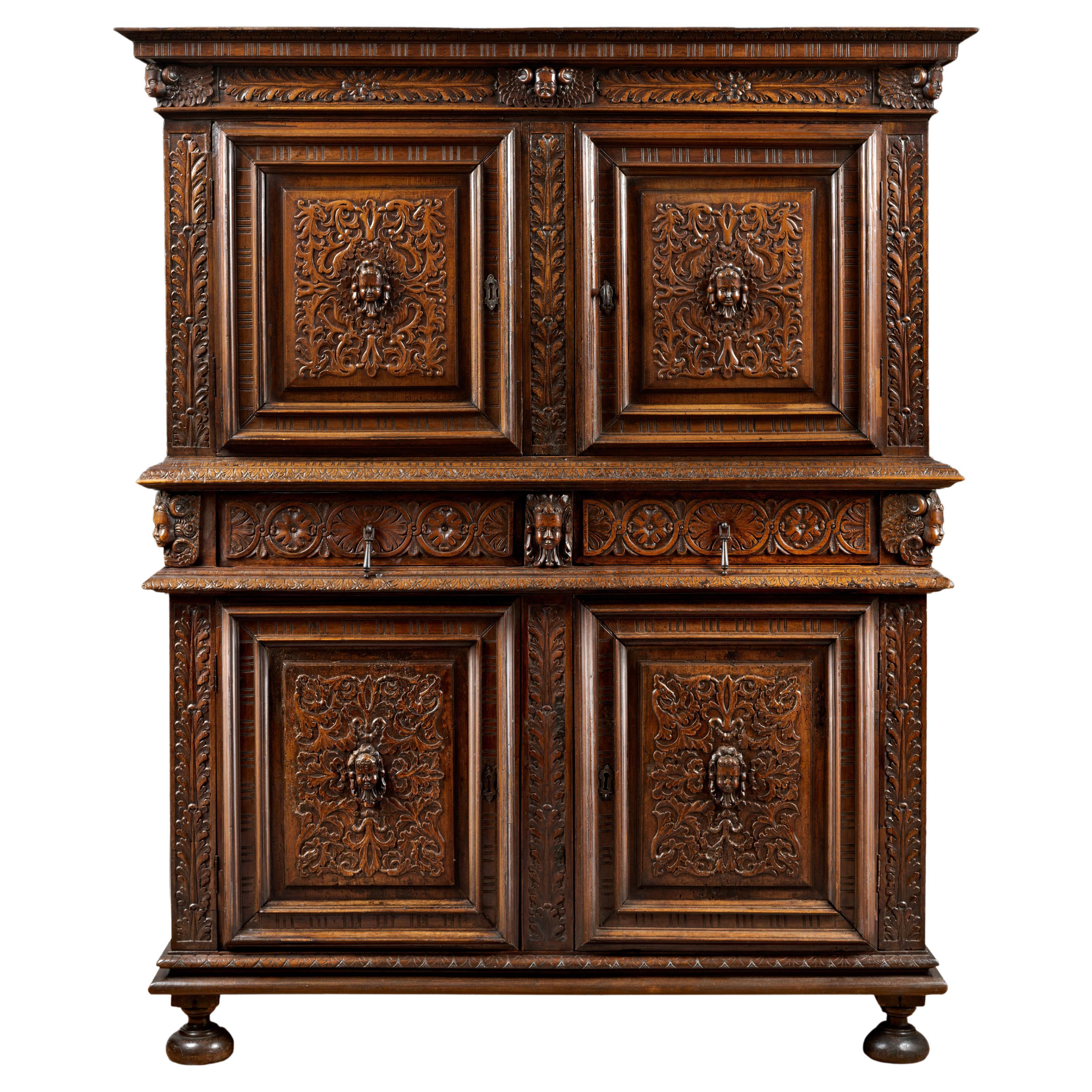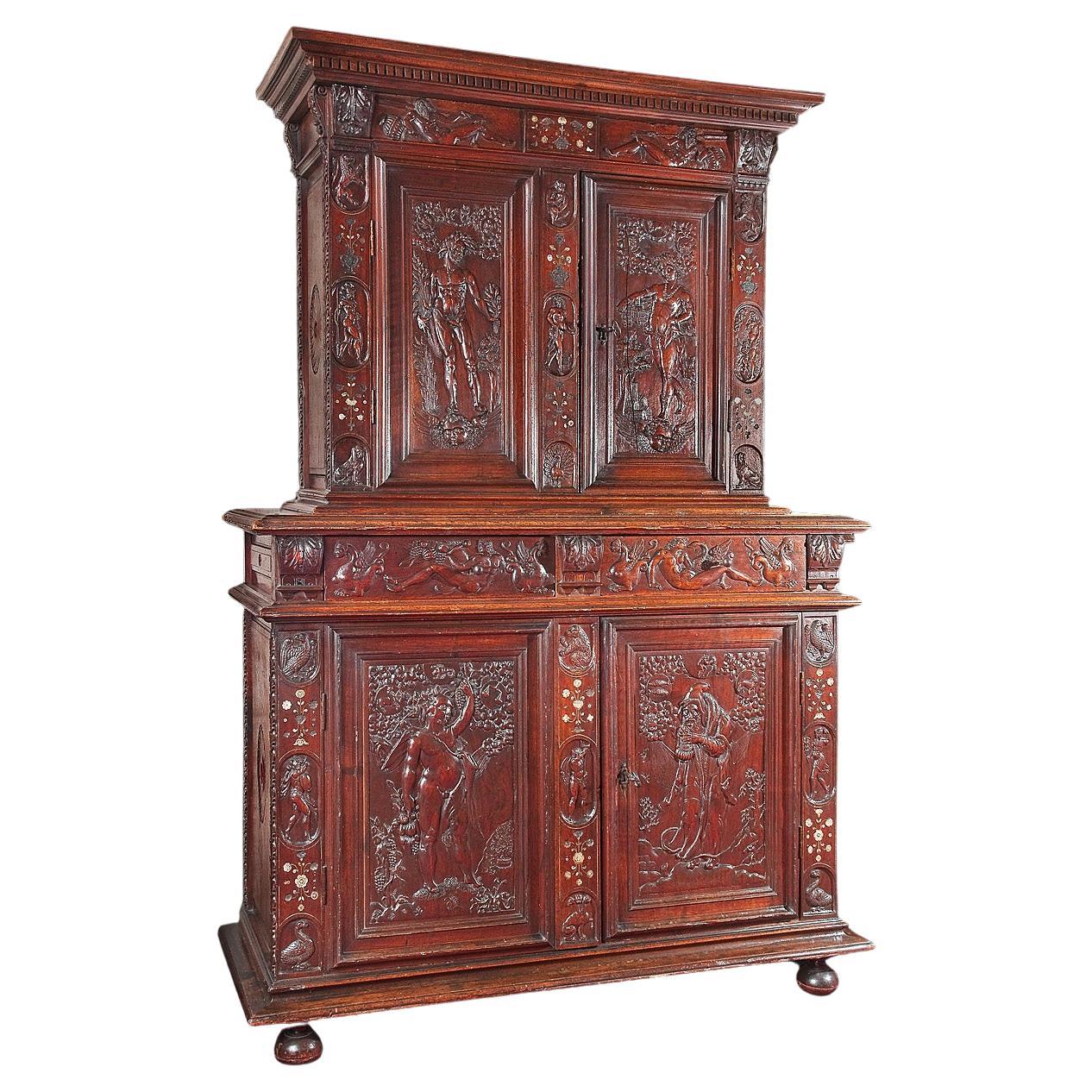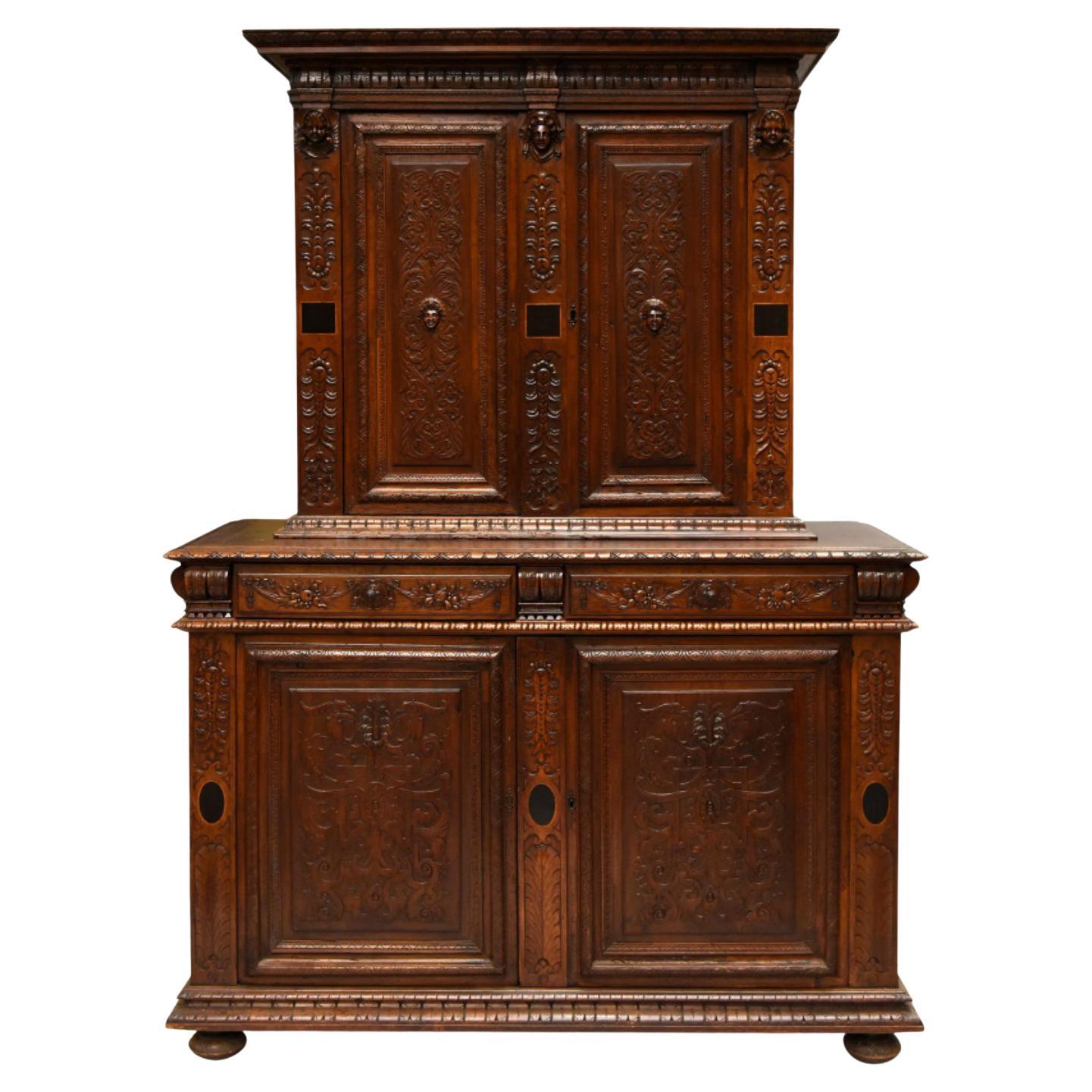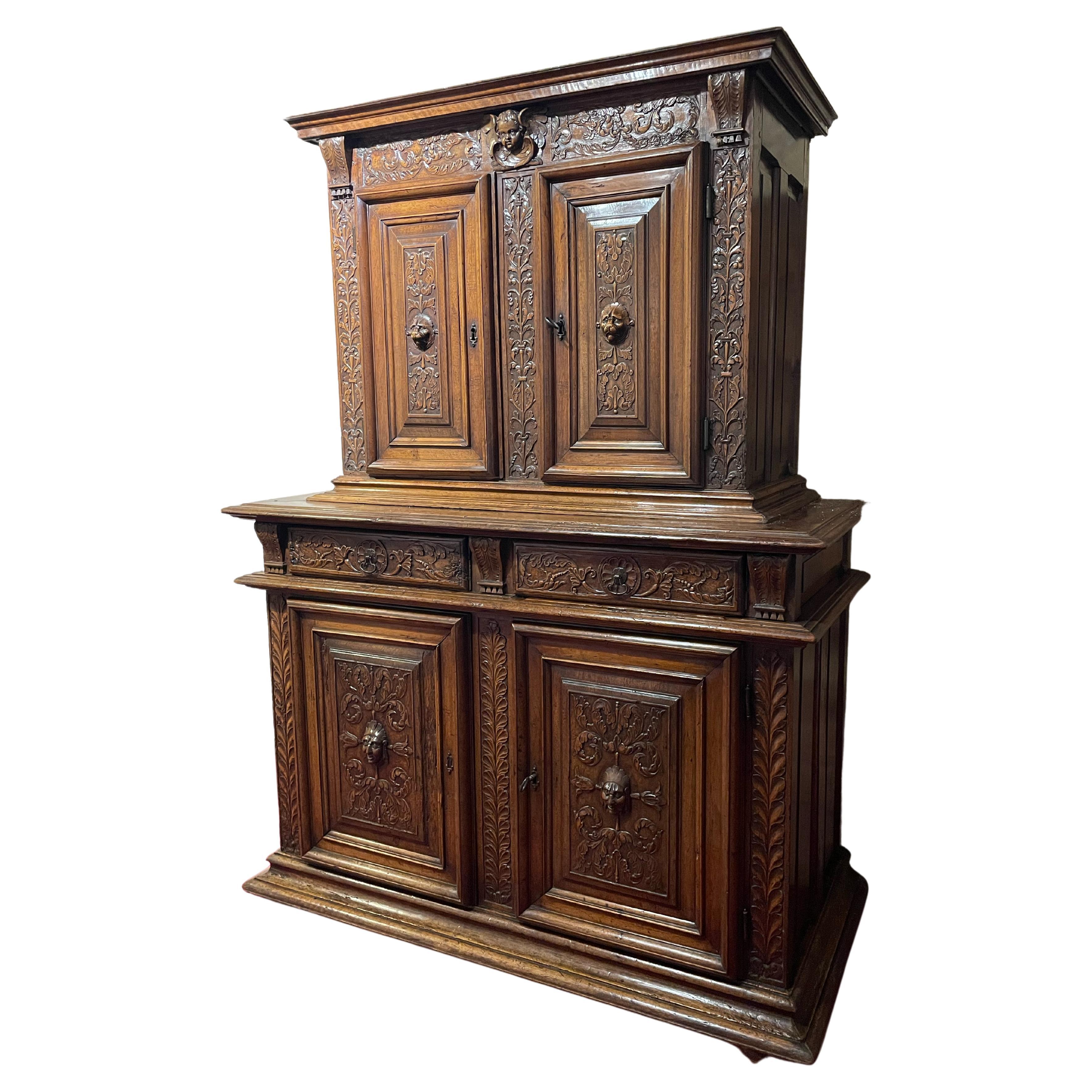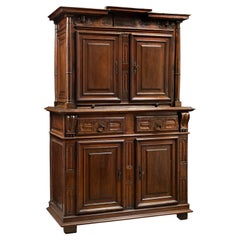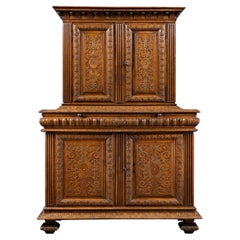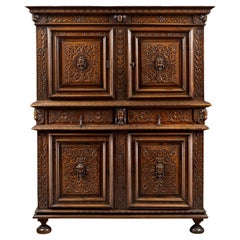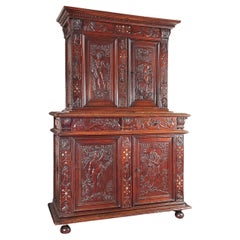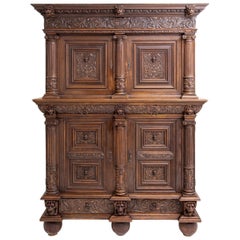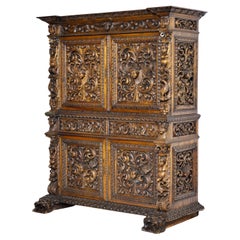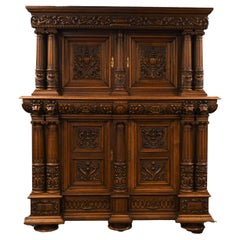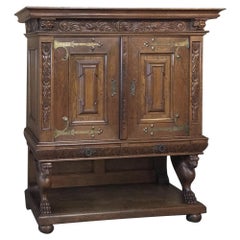Items Similar to Rare Cabinet depicting the Four Elements
Want more images or videos?
Request additional images or videos from the seller
1 of 4
Rare Cabinet depicting the Four Elements
$45,052.64
£33,717.03
€38,000
CA$62,154.03
A$69,117.86
CHF 36,302.20
MX$845,035.24
NOK 452,360.19
SEK 426,453.48
DKK 289,274.87
About the Item
RARE CABINET DEPICTING THE FOUR ELEMENTS
ORIGIN : FRANCE
PERIOD : CIRCA 1600
Height: 178 cm
Width: 112 cm
Depth: 50 cm
Former Perpitch Collection
Former Jacqueline Boccador Collection
This well-proportioned piece consists of two slightly recessed bodies, four drawers in the middle section, and a large drawer at the base. The quarter-round moldings and the guilloche patern at the base of the frieze already announce the transitional period around 1600.
The structure, while still rigorous, remains very harmonious, and the iconographic interest is significant. Indeed, each of the doors is sculpted in bas-relief, executed by a very skilled chisel, depicting the Four Elements directly inspired by prints from the Dutch artist Hendrik Goltzius, dated 1586 and engraved by one of his students. Only the details of the backgrounds are modified.
In the upper part, Earth holding its horn of plenty faces Air resting on clouds, with birds on both sides.
In the lower part, the Water Source leaning on the urn, pouring its water, respects the attitude of Goltzius' allegory. The small tree in the background on the left, overlooking a rock, is preserved here. Opposite, Fire presents, in a gesture identical to the engraving, symbolic lightning and flaming grenades.
The doors of this piece superimpose from left to right Earth and Water, Air and Fire. The powerful morphology of the characters and the mannerism of the attitudes remain perfectly faithful to the prints of the Dutch artist.
It should be noted, however, that the Christian symbolism depicted on Goltzius' Elements – the Baptism of Christ for Water, the Descent of the Holy Spirit for Air, the Creation of Adam for Earth, and the sacrifice of Elijah for Fire – has not been reproduced by the sculptor, who focused on the foreground characters and some landscape details.
Text by Jacqueline Boccador, "Le Mobilier Français du Moyen Age à la Renaissance," Editions d’Art Monelle Hayot, 1988, p. 262-263.
The piece is reproduced on p. 262, ill. 198.
- Dimensions:Height: 70.08 in (178 cm)Width: 44.1 in (112 cm)Depth: 19.69 in (50 cm)
- Style:Renaissance (Of the Period)
- Materials and Techniques:
- Place of Origin:
- Period:
- Date of Manufacture:1600
- Condition:Wear consistent with age and use.
- Seller Location:Saint-Ouen, FR
- Reference Number:Seller: 1811stDibs: LU3115341305602
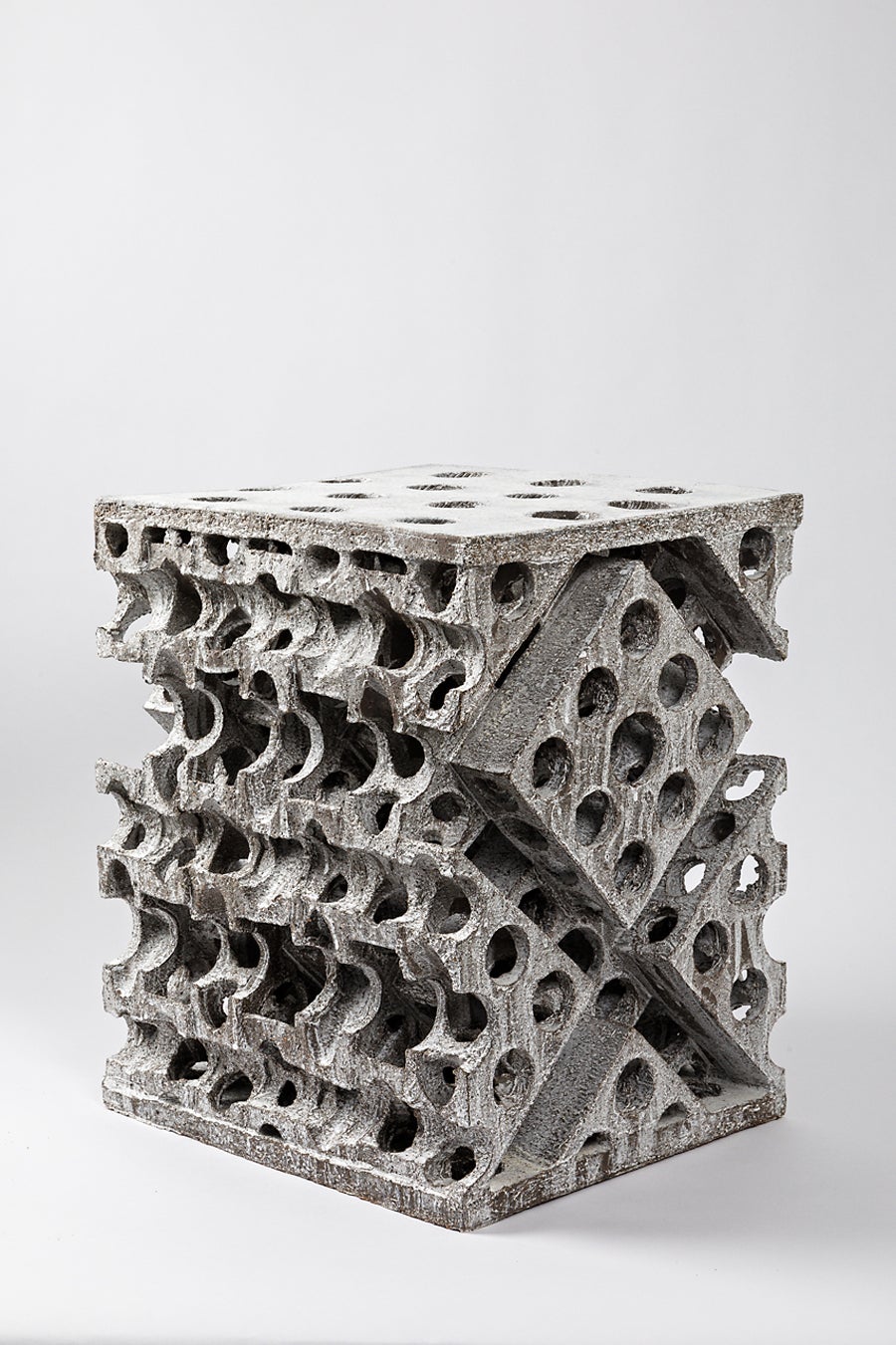
About the Seller
5.0
Vetted Professional Seller
Every seller passes strict standards for authenticity and reliability
Established in 2016
1stDibs seller since 2017
193 sales on 1stDibs
Typical response time: 2 hours
- ShippingRetrieving quote...Shipping from: Paris, France
- Return Policy
Authenticity Guarantee
In the unlikely event there’s an issue with an item’s authenticity, contact us within 1 year for a full refund. DetailsMoney-Back Guarantee
If your item is not as described, is damaged in transit, or does not arrive, contact us within 7 days for a full refund. Details24-Hour Cancellation
You have a 24-hour grace period in which to reconsider your purchase, with no questions asked.Vetted Professional Sellers
Our world-class sellers must adhere to strict standards for service and quality, maintaining the integrity of our listings.Price-Match Guarantee
If you find that a seller listed the same item for a lower price elsewhere, we’ll match it.Trusted Global Delivery
Our best-in-class carrier network provides specialized shipping options worldwide, including custom delivery.More From This Seller
View All16th Century Renaissance Two-Bodied Cabinet
Located in Saint-Ouen, FR
Former collection Altounian
At the beginning of the reign of Henri II (1547-1559) the furniture’s ornamentation evolves. The few medieval motifs that were still used are eventually relinquished. Furniture becomes more sober showcasing moulded panels and perfect architecture. Cabinet-makers use ornaments such as curved fluted or plain columns, feather quills, roses or winged putti heads. High-relief carving becomes more scarce and compositions lighter. To that end cabinet-makers draw inspiration from Fontainebleau motifs filtering them and adapting them to French taste.
During this period cabinet-makers turn into a kind of architects. Indeed the architectural balance of furniture is the centre of their concerns. The study of Antic formulas is then a necessity. From this care given to proportions appear refined cabinets with pure lines.
This style is characteristic of the reign of Henri II and disappears soon after under the regency of Catherine de Medici (1560-1574) when an abundance of high and low-relief ornaments comes back on furnitures.
This two-bodies cabinet...
Category
Antique 16th Century French Renaissance Cabinets
Materials
Walnut
Exceptional Renaissance Cabinet from Lyon
Located in Saint-Ouen, FR
Exceptional Renaissance Cabinet from Lyon
Origin: Lyon, France
Period: 1540-1580, Second French Renaissance
Measures: Height: 188 cm
Length: 132 cm
...
Category
Antique 16th Century Cabinets
Materials
Walnut
Small Renaissance Cabinet from Lyon
Located in Saint-Ouen, FR
Small renaissance cabinet from Lyon.
ORIGIN: FRANCE, SCHOOL OF LYON
PERIOD: 16th CENTURY
Height:151cm
Depth: 120cm
Length: 54cm
Walnut ...
Category
Antique 16th Century Cabinets
Materials
Walnut
Rare Renaissance Cabinet Richly Carved
Located in Saint-Ouen, FR
This rare Renaissance cabinet is richly decorated on the doors and drawers with carvings depicting the four seasons, and on the uprights and the entablature, alternating flower bouquets inlaid with mother of pearl. This is a beautifully conceived piece of furniture, representing a crowned portico with its entablature and cornice.
The upper body
Articulated separately in a ternary rhythm, as with the lower body, the upper part opens with two carved doors. The doors are framed by both the lateral uprights and the casing. There are cartouches carved into the casing in which mythological figures are depicted with flower bouquets.
On the doors:
On the right: Spring, a female figure crowned with a wreath of leaves, holding a basket full of flowers. She is wearing necklaces and bracelets on each arm, with drapery discretely wrapped around her body and is standing on a winged putti’s head. On each side are depicted a tree and a village with a steepled church. Above her head floats the three signs of the zodiac corresponding to the season: Aries, Taurus and Gemini.
On the left: Summer, a bearded man crowned with ears of corn and bearing armfuls of corn. He is standing on a similar winged putti, flanked by a tree and an ear of corn. The following three signs of the zodiac appear: Cancer, Leo and Virgo.
On the uprights and the central casing a number of smaller figures seem to represent virtues and vices that newly wedded couples should aspire to and avoid.
On each side, at the bottom of the uprights, there is a dog representing fidelity. Above, a lion embodies power, wisdom, and justice.
In between, on the left upright, there is a figure of noncombatant Athena wearing a helmet and holding a spear, an arrow pointing down and in her left hand, a shield, symbol of protective power. On the right upright, the goddess Venus controls the arrow of Cupid.
The iconography here acts as a clear reminder of the required virtues that both parts of a young couple need to fulfill: fidelity, power, wisdom and justice. For him, the goddess Athena focuses on the power. Whereas for her, it is Venus who shows how to control Cupid’s arrow.
On the central casing at the bottom, by way of contrast, there is a peacock, a symbol of pride and at the top, a monkey representing lust and mischief. In between, a woman holding a chain and a cup full of precious stones while on the floor sits a half empty opened casket. This can be interpreted as a symbol of extravagance.
Above, the entablature, decorated with male figures resting on leaking urns, may symbolize the passing of time. They are flanked by two consoles decorated with acanthus leaves and separated by flower bouquets (inlaid with mother of pearl). Finally on top, a cornice acts as a crown for the piece of furniture.
The lower body
The moulded base stands on four round, flattened feet.
Represented on the doors:
On the left: Autumn, a stocky, naked man crowned with vine leaves, holding fruits in his right hand and with his left, picking a bunch of grapes from a climbing vine. Standing on a mound, he is surrounded by a vine and a hill, at the foot of which a man presses the grapes in a big vat after the harvest. Above the climbing vine appear the signs of Libra, Scorpio and Sagittarius.
On the right: Winter, an elderly man wearing a fur cloak...
Category
Antique 16th Century French Renaissance Cabinets
Materials
Walnut
Renaissance Cabinet form Lyon 'France'
Located in Saint-Ouen, FR
Condition : Partly dating from the Renaissance. The backs and the drawer’s insides have been re-done.
Historical background
The 16th century is a prosperous period for Lyon...
Category
Antique 16th Century French Renaissance Cabinets
Materials
Walnut
Small Renaissance Cabinet
Located in Saint-Ouen, FR
Small renaissance cabinet
ORIGIN : FRANCE
PERIOD : END OF THE 16th CENTURY
Measures: height: 167 cm
length: 123 cm
depth: 58 cm
This small two-part unit with harmonious proportions opens with four front leaves and two belt drawers. It rests on a molded base.
The uprights and the central frame of the lower body are adorned with long stylized palmettes. They frame the four leaves on which unfolds a vegetal decoration made of stems and leaves sculpted in symmetry around two mascarons topped with feathers...
Category
Antique 16th Century French Renaissance Cabinets
Materials
Walnut
$17,783
You May Also Like
Neo-Renaissance Cabinet, Late 19th Century
Located in Greding, DE
A four-door cabinet in Renaissance style standing on ball feet with lion's head mascarons and half-columns with volute capitals. The doors with panels and vine decoration are separat...
Category
Antique 19th Century German Renaissance Revival Cabinets
Materials
Wood
RENAISSANCE TWO BODY CABINET 19th Century
Located in Madrid, ES
RENAISSANCE TWO BODY CABINET 19th Century
In oak wood
Upper part with two profusely carved doors.
Lower part with two drawers and two doors.
Decorated with plant motifs, zoomorphic ...
Category
Antique 19th Century Portuguese Baroque Cabinets
Materials
Wood
$8,820 Sale Price
20% Off
Antique Carved Wood Cabinet
Located in MC Leansville, NC
Step into old-world grandeur with this masterfully crafted antique carved wood cabinet. Towering with architectural grace, this piece is a statement. Hand-carved columns, floral moti...
Category
Antique Late 19th Century Unknown Neoclassical Cabinets
Materials
Wood
19th Century Dutch Hand Carved Renaissance Raised Cabinet
Located in Dallas, TX
19th century Dutch hand carved Renaissance raised cabinet was rendered from dense, old-growth quarter sawn oak, examples of which are on displa...
Category
Antique Mid-19th Century Dutch Renaissance Revival Wardrobes and Armoires
Materials
Steel
19th Century Neo-Renaissance Cabinet Closet
Located in Berlin, DE
19th century Neo-Renaissance cabinet closet
Oak, solid. Richly carved, grotesque carved, two-door cabinet, centered with portrait medallions, resting on a bivouac and on pillars, ...
Category
Antique 19th Century German Renaissance Revival Cabinets
Materials
Oak
Renaissance Buffet Representing The 4 Seasons Circa 1580 - France
Located in Brussels, Brussels
Superb and rare Renaissance period walnut buffet from the end of the 16th century representing the four seasons opening with four doors and two drawers on the front,
The doors offer...
Category
Antique 16th Century French Renaissance Buffets
Materials
Walnut
